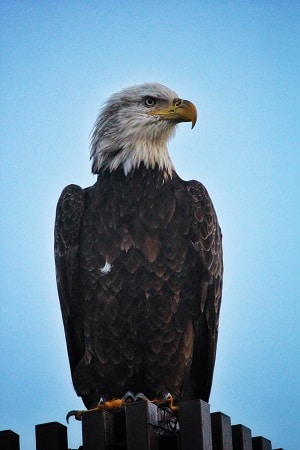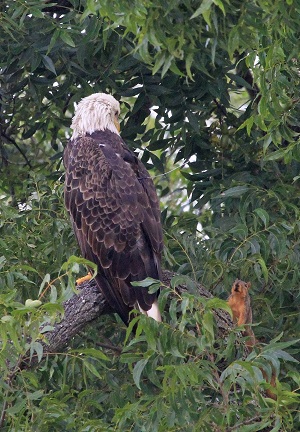

Summer was kind to us in Oklahoma this year with milder temperatures and ample rainfall. That same summer weather has lingered well into October. The trees are still full with leaves and the pasture remains green, but the landscape is finally starting to yield to fall’s crisp night air as those greens give way to gold and orange hues. The wildlife around the aviary has changed as well. The turkeys have returned and are regular visitors to the deer feeder. Our resident red tailed hawks have started their aerial courtship displays and by dusk you can hear the great horned owl pairs calling back and forth throughout the night. We haven’t seen one scissortail flycatcher this past week and the hummingbirds have all but disappeared except for migrants who stop at the feeders as they pass through. The sky overhead is full with migrants heading south daily. We have spotted turkey vultures and black vultures drifting by in huge kettles, along with Mississippi kites, whip-poorwills and pelicans, to name just a few. With all this activity we couldn’t help but wonder if Wadasé Zhabwé would be on the move as well.
Studying Wadasé’s telemetry over the past several weeks, we have noted that she has visited several new areas in the past few months. She spent nearly two weeks southwest of Mulhall on Skeleton Creek that runs into the Cimarron River. After her stay there she headed towards the South Canadian River. Once there, she meandered up and down the river, west past Union City and back east between Mustang and Tuttle. She even spent a few days working her way around Lake Overholser, but true to her routine she returned to the North Canadian River near the lake. Along with these new sites, she has returned to many areas she frequented in the past at this same time of year where there are active eagle nests. Perhaps those eagles have returned to the area and she is, once again, following adult eagles. But for the first time, as breeding season for eagles’ approaches, she is in fact a mature adult eagle herself. There is a strong possibility that she could choose a mate and find a place to raise young this winter. She has spent the last three and a half years exploring new areas around the central third of the state and may already have a place in mind. We are always hopeful she might choose the aviary grounds but it has been months since her brief visit last February. Thankfully, we continue to get consistent data from her telemetry backpack and with a little luck, if she nests this season, we can continue monitor her progress as an adult.
We skipped an article in the previous paper because there was really no new information to share about Wadasé. In the past, when that’s the case, she has been notorious for showing up the day before or of the deadline for the paper. This has resulted in us writing an article at the last minute, but this time she was a few days too late for our article’s inclusion in the October Hownikan. Shortly after the October paper’s deadline, Wadasé began heading east towards Dale and since August she had not been that close to home.
On September 13 we heard the eagles calling throughout the day but never saw anything. Towards the end of the day we surveyed the sky above the pasture one more time as we headed out the door to lock up. When we stepped out onto the front sidewalk, we heard a familiar chatter. Wadasé was home! To our complete surprise, she was sitting on the corner of the aviary, watching us. 216 days had passed since her last visit. Nearly eight months had gone by, but she seemed right at home. Although this visit turned out much different than the last.
As always, we offered her food, and this time she didn’t pass up a free meal. She spent the better part of the evening sitting and sunning on her favorite perch out front and just before dusk she flew to the east. The following morning, she arrived at sunup for breakfast and did so for the next six days.
Wadasé had not been here for more than 3 or 4 days in a row since the first year she was released. She also proved to be nearly impossible to photograph unless she was perched in obvious places. Not only was she hard to locate with the amount of leaves still on the trees but she was often sitting in new places and was much faster and capable when retrieving any food we provided.
During her time here we were able to download new telemetry data. Now we know that she actually came in the night before we saw her and was in the area the all of the following day. The eagles had seen her but we did not, at least not until she wanted us to.
Midday on September 20 she headed north towards the river. We didn’t see her the rest of the day and the following morning she didn’t return for breakfast. Perhaps this was her yearly visit or maybe she was checking the area for potential nest sites. However that knowledge isn’t part of the satellite data provided by her telemetry, so we will have to wait and see. Until then we know that she is thriving in the wild and stronger and more equipped to survive in the wild than we had imagined. Wadasé Zhabwé is everything a warrior carrying all of our peoples prayers should be.
For more information about Wadasé or the other eagles at the aviary visit www.potawatomiheritage.org/#aviary. As always we encourage you to keep your eyes out for Wadasé if you are near the areas she frequents. Send your encounters with Wadasé or any other eagles in Oklahoma or wherever you may be to us at aviary@potawatomi.org.
